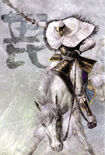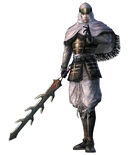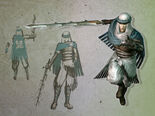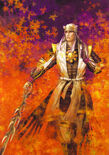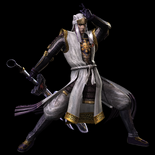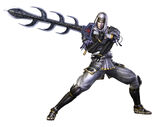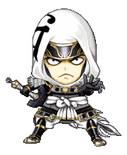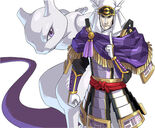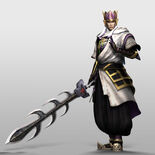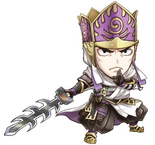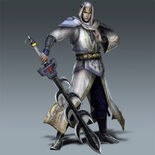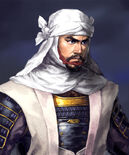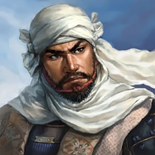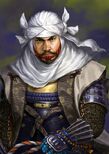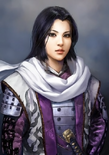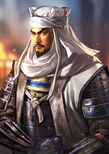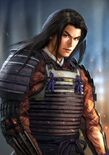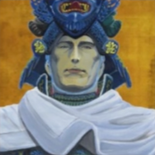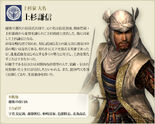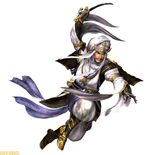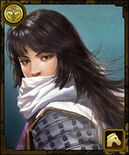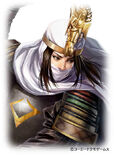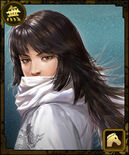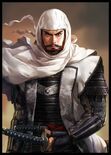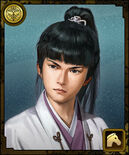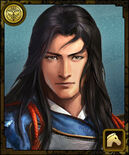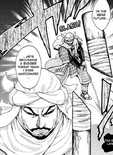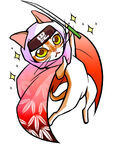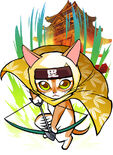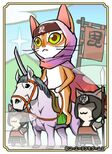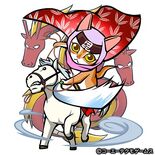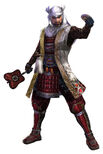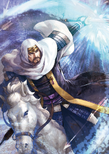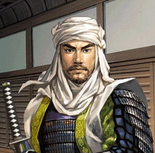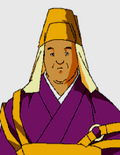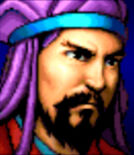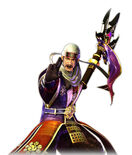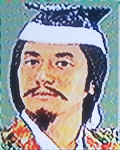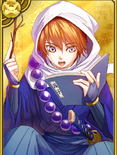| Kenshin Uesugi | |
| Clan(s)/Alliance(s): | Uesugi |
|---|---|
| Age: | 36
|
| Height: | 198 cm (6'6")
|
| Weapon(s): | Seven bladed sword and exploding shikigami (paper dolls) |
| Heirloom: | Mounted Chalice
|
| Moveset Type: | Normal
|
| Significant Battle(s): | |
| Playable Debut: | Samurai Warriors |
| Real name: | Uesugi Kenshin
|
| Japanese name: | 上杉 謙信
|
| Born: | February 18, 1530
|
| Died: | April 19, 1578
|
| Force: | |
| Stage: | |
| Character Type: | |
| Personal Item: | Chalice of Bishamonten
|
Kenshin Uesugi is the sixteenth head of the Uesugi clan who clashed with several prominent figures of the era within his region of influence, Echigo. He is famous for being masterful in war and for his devout worship of Bishamonten, the Buddhist god of war. After his death he is known under several nicknames, which include the Avatar of Bishamonten, Dragon of Echigo, and the God of War. His rivalry with Shingen and their battles at Kawanakajima have been romanticized as chivalrous games of wits between them. Aya is his elder sister while Kagekatsu and Kagetora are his adopted sons.
Before the start of every battle in the Samurai Warriors series, he prays to Bishamonten. Fans voted him to thirty-seventh place in Gamecity's Sengoku Musou 3: Empires character popularity poll. For the Samurai Warriors 4 poll, he placed fifty-first. This Samurai Warriors counterpart also has an image song called Bi·Kawanakajima Senka.
Role in Games
"You are even a match for my father!"
- ~~Guan Ping; Warriors Orochi
Samurai Warriors
Kenshin is the known as the Dragon of Echigo who is rivals with his neighbor and "nemesis", Shingen. He first leads a campaign to defeat his adversary. After clashing wits and blades at Kawanakajima, he becomes further fascinated in seeing his rival's true colors in combat. Being the diplomatic one of the duo, however, Shingen has no interest in staying and turns the Hōjō against him. To counter, Kenshin invades Odawara Castle to single-handily deal with Ujimasa. Suspicious when Yukimura and Kunoichi are present within the castle, he learns from Ujimasa that the whole incident is a diversion from Shingen's march towards the capital. Speeding his troops immediately north in an attempt to pursue, the Uesugi face the Sanada at Ueda Castle. While Shingen makes a brief appearance on the field to save his men, he slips through Kenshin's grasp due to Masayuki's planning. Hoping to block Shingen's path by cutting to the west, Kenshin leads his men to put an end to the Oda at Gifu Castle. He has the option of impressing Keiji with his might, gaining another ally for his cause in the following battles.
If Kenshin takes too long, Shingen crosses into Owari and the rivals face one another at Anegawa. Determined to put an end to their differences once and for all, Kenshin slays the Takeda. In the midst of his overzealousness, he finally sees the war-driven expression he wanted from Shingen and is satisfied. However, in their duel, Kenshin kills Shingen and unexpectedly becomes the new ruler of the land. After praying for his success, he solemnly toasts to Shingen's burned war banner.
Should he deal with Nobunaga quickly, his efforts causes Shingen to abandon his march and the rivals decide to settle everything once more at Kawanakajima. Intent on only defeating his nemesis in combat, he routs the Takeda army and defends his men from Hanzō. With Shingen finally defeated, the elder one expects Kenshin to take his head. Kenshin, accepting his nemesis' qualities through their duel, shares a cup of wine with him and is content to leave the land in Shingen's hands.
In Samurai Warriors 2, he acts as a mentor for his son and Kanetsugu. After fighting several battles with Shingen, he wins the fourth encounter at Kawanakajima. With neither content to call it their final confrontation, they each returned to their own territory. Cleansing his home of bandits, he learns that Shingen is marching towards the capital. Refusing to have Nobunaga steal the glory of taking Shingen's life, he supports his nemesis at Nagashino. Parting ways to follow their own paths towards the capital, Nobunaga races his army to avenge their loss against Kenshin. Dispatching the stranded Oda troops and slaying Nobunaga at Tedorigawa, Shingen simultaneously dealt with Ieyasu. With both of their plans delayed, the rivals meet at Sekigahara and have a spirited showdown to see who shall rule the land. Enjoying the battle of wits with Shingen, he releases his prisoner and asks that they work together. To honor their new friendship, they join their hands with a single cup.
His dream stage has them conquer the rest of Japan. The last piece of their journey is Kyūshū, where they face the Shimazu and the remnants of the Oda clan.
Samurai Warriors: Katana has Kenshin appear in the Stealth scenario as the player's first opponent. Having taken Kawagoe Castle from the Hōjō, he bars the Fūma ninja from rescuing the imprisoned Tsunashige only to fail.
The third title dubs Kenshin as one of the three great powers in Kantō, sharing the right with Shingen and Ujiyasu. Valuing duty and justice, he only rides into war to satisfy these simple desires with his older sister by his side. Defending Norimasa Uesugi against Ujiyasu at Odawara Castle, Kenshin simultaneously defeats him and Shingen. Merely content to fulfill his duty to Norimasa, however, he orders his troops to withdraw rather than take the castle for himself. Clashing with Shingen at Kawanakajima and winning the fourth conflict, he promises to someday show his sister what he truly seeks to achieve from his wars. As the conflicts within Kantō continue, the alliance between Shingen, Yoshimoto, and Ujiyasu begins to lose its influence. Taking advantage of the weakness, Shingen takes sides with Ieyasu and the two forces attack Suruga. The isolated Yoshimoto pleads for aid and Kenshin answers the call. Upon his defeat, Shingen decides to entrust his plans for leadership to Kenshin. Seeing on equal ground with Ujiyasu, who is now free from dealing with Yoshimoto, the wars within Kantō subside.
However, the upstart Nobunaga sets his sights on the Takeda soon after to wrestle control for himself. To stop him, Kenshin decides to ride towards Tedorigawa and is surprised to have his water attack countered by a fire attack on both armies. Unable to completely destroy Nobunaga, the Demon King quickly expands west by suppressing the Mōri and Chōsokabe clans. Intent on ending the evil threat, his army rides to Shizugatake. As he struggles, Shingen and Ujiyasu comes to his rescue. Uniting the land with his new comrades, his harmonious actions greatly please his older sister. She proudly congratulates his efforts with a glass of wine.
In Samurai Warriors Chronicles, Kenshin first appears in the third and fourth battles of Kawanakajima against Shingen Takeda. The Protagonist joins Kenshin in the third battle but opposes him in the fourth battle. After fighting in these indecisive battles, the Uesugi leader turns his attention further south in Kantō when Matsuyama Castle rebelled and joined the Hōjō. Unfortunately for him, he loses the battle and his control over Kantō becomes nonexistent. Despite these setbacks, Kenshin remains in command of a powerful army and next turns his consideration to the rising star of Nobunaga Oda. Kenshin managed to lure and trap the Oda forces at Tedorigawa, where he unleashed the dammed river's waters and greatly damaged Nobunaga's army. Despite this success, Kenshin grew ill shortly afterwards and died back home in Echigo. In the Gaiden stages, Kenshin appears at the beginning of the conflict of Otate, where he dies before he can choose which of his sons will replace him, only managing to say that Kage. . . will replace him, leaving both sons as an option for the legitimate heir and provoking a war of succession. He also fights in the DLC mission of Heroes Collide alongside Shingen and Ujiyasu, working together to overcome Nobunaga, Hideyoshi, and Ieyasu, the three unifiers of Japan.
Samurai Warriors 4 Kenshin begins as an influential power in the east with an ongoing rivalry with Shingen. He only marches into battle at the wishes of others, never for his own gain. When the Hōjō seek to expand and threaten the nobility in Kantō, they implore Kenshin for aid at Odawara Castle. Although he is weary of his nemesis's movements, Kenshin is honor bound to answer their plea and rides to intercept the Hōjō forces. Regardless of the version or outcome, the Hōjō and Uesugi agree to a peace treaty by sending Saburō Hōjō as a hostage to Uesugi. Kenshin stops the despondent youth from committing suicide when he arrives in Echigo. The Uesugi lord warmly welcomes the youth as one of his own, giving him a new family with the name Kagetora Uesugi. Throughout the Uesugi chapter, Kenshin acts as a receptive foster father for Kagetora.
As he had predicted, Shingen moves again in the north by capturing Kaizu Castle. The pleas of his family retainers leads to Kenshin's interception at Kawanakajima. Kenshin reads through Shingen's tactics in either version of the battle, proceeding to capture the northern mountain path for an ambush. Afterwards, Shingen perishes to illness and the Oda threaten the eastern provinces. Noto nobles request for Kenshin to defend them, leading to the clash at Tedorigawa. Prior to the battle, Kenshin notices Kagekatsu's uncertainty towards his brother and encourages him to be honest with his feelings. After the water attack drives Nobunaga back, the Uesugi family rejoices their victory in the camp. Moments before Kagetora openly voices his brotherly love towards Kagekatsu, Kenshin suddenly collapses. The narrative explains he later perishes due to illness.
Warriors Orochi
When Orochi first arrives into the new world and conquers Shu, Kenshin and Shingen decide to unite their strengths to resist him. They challenge Orochi at Kawanakajima. After Shingen sets fire to the serpent troops in Hachimabara, Kenshin decides to lead his troops straight into Dong Zhuo's main camp. He and his troops escape capture.
During the first title, Kanetsugu reports Nobunaga's worth to him, which interests him enough to lend his support. Both he and Shingen stall the Orochi forces lead by Cao Pi and Sun Quan at Nagashino. Claiming victory against the overwhelming odds, they ride together to support Nobunaga's charge at Wu Zhang Plains. With Da Ji subdued and Orochi dead, he parts ways with his rivals to look forward to more days of glorious war.
When Sakon saves Kanetsugu at Hasedo, his young vassal grants his new friends an audience with Kenshin. Agreeing to join the new coalition as thanks, he later leads the eastern battalion at Bai Di Castle. He fights his way through ambushes to corner Kiyomori. He shares his dream stage with Xu Huang and Guan Yu. The trio of warriors rescue Yoshitsune and his allies from Kiyomori's army. Kenshin encourages Ieyasu to keep up the fight. When Yoshitsune returns with aid, Shingen appears to reinforce him.
Kenshin led his troops around the dimensional realm in Warriors Orochi 3's original timeline to eradicate villainy. When Hydra emerged, the massive serpent forces defeated and scattered the Uesugi army. His whereabouts are not verified after his defeat. When the coalition return to Da Ji's past and alter history, Kenshin allies with Shingen to oppose them at Shizugatake, thinking that the warriors have fallen under Da Ji's influence. Respecting their resolve after being beaten by them in combat, he allows Aya to watch over them.
Unwilling to accept servitude to the demon at the time, Kenshin helps the coalition obtain the firepower they need to defeat Hydra at Osaka Castle. He formally joins the coalition with his rival once they obtain victory and later helps Jia Xu's plan to gain Dian Wei's trust.
Kenshin stars in the downloadable stage, "Warriors of Purity", where he and Xu Huang help Aya in destroying evil and show that their white hoods are symbols of purity.
Pokémon Conquest
Like his rival, Shingen, Kenshin is reputed throughout Ransei as a powerful Warlord in Pokémon Conquest. As Nobunaga causes the castles in the north and center to submit, only Kenshin and Shingen remain free from his influence. Meanwhile, the protagonist has largely taken the southern part of Ransei. The protagonist and Oichi hope to mediate with the veterans and convince them to fight against Nobunaga.
If the player chooses to approach Kenshin's Illusio Castle, he refuses the offer outright. He has no interest in joining forces with him/her without experiencing their mettle in battle. After Aya and Kanetsugu test their prowess, Kenshin welcomes the protagonist with a second chance to prove themselves to him. Once the protagonist wins a second time to his forces, Kenshin recognizes him/her as his friend in arms. Shingen, who had watched their fight, spares the player the fight for his castle by volunteering his trust to the protagonist thereafter. Oichi celebrates the union by making food for their victory banquet.
Kenshin remains as a permanent ally character throughout the main story. He congratulates the protagonist during the main story's ending by praising their strengths in conflict. Before he returns to Illusio, he leaves with his wish for a friendly rematch with him/her.
In his personal scenario, he and Shingen have both halves of Ransei under their respective command. Shingen insists that they're too strong to overpower one another so he instead challenges Kenshin to another proposition: whoever wins five battles first is declared the victor between them.
Kessen
Kenshin and his massive army appear as an optional foe in Kessen III. Toshiie and Katsuie were badly defeated in a skirmish and are requesting reinforcements from Nobunaga's main forces. Although none of Kenshin's forces will join Nobunaga's cause, several rare items can be found on this stage. If the players don't choose to fight him, Nobunaga will report that he dies due to illness.
Character Information
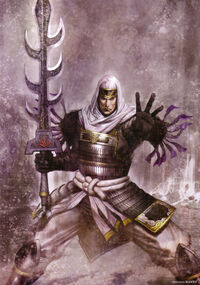
Kenshin's artwork in Samurai Warriors 3.
Development
As far as changes from pre-planning goes, Kenshin is similar to his rival Shingen. Both characters took inspiration from historical statues and images around Japan and didn't change much from his initial concepts. His stoic face and pale complexion were designed to make him appear to be always ready for battle. Overall, his character was made to be a muscular and determined individual who possesses "power that surpasses age". His alternate costume was made to emphasize the Bishamonten kanji that often decorated his war banners.
For his revamp in the second title, designers wanted to make him the "war god". They kept ideas regarding his physical traits but made efforts to make his white coat "simple yet intimidating". The designers comment that the gold and purple accents help make him stick out from his older design. His charm point is that his insignia now decorates his back.
The headpiece for his fourth outfit is based on the helmet of Sanpokojin, one of the Japanese Buddhist temple deities known for punishing the wicked. Designers wanted more Buddhist ideas incorporated into his costume to match his trademark white clothing. The concepts for his design were drawn by his illustrator, Nariann.
Personality
Adept in battle and a capable strategist, Kenshin proudly follows the tenants of his war god, Bishamonten. To this end, he strives for "pure war" in his campaigns, or battles fought with clear motives and unplagued by trickery. In respect to his beliefs, he often prays to his god for good luck and fortune for his strategies and men. Possessing a divine presence himself with his decisiveness, he is often revered by his troops as a prestigious man of virtue and merit. He isn't much of a conversationalist to those he doesn't deem worthy to face him, believing that battle is the honest way of expressing one's thoughts and feelings. In his following appearances, he shows a degree of restraint for conquest and pride for his troops.
Though rivals with Shingen, he is civil and admires his abilities. Often calling him "nemesis", Kenshin is proud of the honorable battle of wits they engage in and thoroughly enjoys their encounters. He glorifies their face-offs, easily infuriated when unwanted parties barge into their fights. Both generals understand one another, though Kenshin jests that his skills sometimes pales in comparison to his rival. He shares the same type of judgment towards Ujiyasu, but their relationship isn't as stressed. Despite his stern composure, he is humble and protective towards Aya. Revering her with high regard, he wishes to impress her and will always hurry to her aid if she is in danger.
By contrast, he labels Nobunaga as an outright villain who isn't responsible enough to have power. Declaring that he is the figure who will strike him down, Kenshin thinks himself superior to his opponent in morality and war.
Character Symbolism
He's symbolized by the characters for "Buddha" (仏) and "assist" (毘) and red maple leaves in the Samurai Warriors series.
Kenshin's titles in Samurai Warriors 2 are "Hero of Kasuga", "Great Warlord", "Dragon of Echigo", "Bishamon Avatar", "Divine Avenger", "God of War", and "Mighty Crusader" (in the Xtreme Legends expansion).
His second weapon -or his first weapon in the second Samurai Warriors title- is called Shichitsukatō, or the seven branched sword. It's the same shape of a legendary type of sword in Japanese mythology named Taokatsu-no-Tsurugi. There are several different versions of either sword, but the sword is well known for being wielded by Susanoo when he struck down Yamata-no-Orochi. Hoori made a Taokatsu-no-Tsurugi for himself when separated from his brother, Hoderi.
Kenshin's fourth weapon -third weapon in the second title and main weapon in the third- is actually the name of a legendary sword Kenshin favored himself, Himetsuru Ichimonji. As the story goes, Kenshin one day acquired a beautiful long sword and grew attached to its well crafted edge. However, it was a little too long for his preferences so he ordered a blacksmith to shorten the sword to half its length. That night when he slept, Kenshin met a beautiful maiden within a dream. She had lovely, long black hair and wept bitterly to herself. When she noticed Kenshin, she tearfully pleaded him to not chop her up. Kenshin realized she was the spirit of the sword he acquired and therefore canceled his order the next morning. Meeting the woman in the dream he had that night, he asked the maiden her name. Answering him before she disappeared forever, Kenshin named the blade after the meetings he had with her ("princess" for when he first saw her and "Tsuru" for when he learned her name). The story is well known for Kenshin's impeccable courtesy, which states he will never allow any woman to cry. To follow the bird motif, his Power version of the blade is named after a rough eagle while his Speed variation is named after a white heron.
The original name for his fifth weapon -fourth weapon in second title and rare weapon in third- takes its namesake from one of the Three Regal Treasures of Japan, the Ame-no-Murakumo-no-Tsurugi. According to legend, the blade was recovered from the tail of the fallen Yamata-no-Orochi.
His sixth weapon -fifth weapon in Samurai Warriors 2: Xtreme Legends- is named after Bishamonten, but the original name implies the sword is named after the glowing aura from the deity. Bishamonten is a god revered for wealth and good fortune. He is sometimes fabled to be Kichijoten's husband to double their auspicious nature. Within the warrior class, it became an avid practice to pray to Bishamonten for success in their campaigns. He has several different forms, but he is well known for holding a trident in one hand and a boxed treasure in the other. When depicted as one of the Four Heavenly Kings, his name changes to Tamonten. In this variation of Bishamonten, he is revered as a powerful god who smites evil spirits in a single swing. He is famously known as a wise, brave, and just god of virtue. The Japanese mantra dedicated to the deity is, "On Beishira Mandaya Sowaka", which is a common quote for Kenshin within the Japanese dub for the series.
Kenshin's personal item in Warriors Orochi and family treasure in Samurai Warriors 4 is originally named bajohai, which is a cup made to conveniently drink wine while on horseback. Kenshin is said to have historically used and favored a bajohai named Katsugahai. Using the tall drinking cup, he would be able to drink by himself or spend the night with his aides to warm himself from the chill of the snowy weather.
Voice Actors
- Beau Billingslea - Samurai Warriors, Kessen III (English-uncredited)
- George Cook - Samurai Warriors 2 (English)
- Philip Hersh - Warriors Orochi series (English-uncredited)
- Troy Baker - Samurai Warriors 3 (English-uncredited)
- Jōji Nakata - Samurai Warriors and Warriors Orochi series (Japanese)
- Akio Ōtsuka - Kessen III (Japanese)
- Mugihito - Nobunaga no Yabou Online
- Hideyuki Tanaka - CR Sengoku no Arashi ~Nobunaga no Shou~
- Hiromu Miyazaki - Sengoku Pachislot Nobunaga no Yabou ~Tenka Sousei~
Live Action Performer
- Satoshi Kojima - Sengoku Bushou Matsuri
- Kimeru - as Uesugi Nyanshin in Butai Nobunyaga no Yabou (Nyan)
Quotes
- See also: Kenshin Uesugi/Quotes
- "Nobunaga! The great Tedorigawa will wash your ambitions away for good!"
- "War is like a fine wine... Come, let us savor its taste."
- "Great Bishamonten, God of War, show me the correct path. Lead us to victory."
- "I lay claim on this derby. Nemesis, you can have the salt."
- "You can't possibly drink wine from that cup all the time, Kenshin. You can tell me. Sometimes that's just water in that cup, right?"
- "The power of Bishamonten gives me the strength to imbibe however much I desire. That, and I have a clockwork liver."
- ~~Magoichi and Kenshin; Samurai Warriors 2: Empires
- "Keiji Maeda... Together with your heroic strength, not even the Heavens could stand against us."
- "Butterin' me up with dignity without actin' startled or your losing wits around me... That's mighty impressive composure, just what you'd expect from the God of War himself. I'd better not be monkeying around in front of you."
- "A pity. I would have liked to have seen your monkey act."
- ~~Kenshin and Keiji; Sengoku Musou 3: Empires
- "The only path to Orochi is through me!"
- "Very well... Let us drink from the sweet chalice of war together."
- ~~Lu Bu and Kenshin; Warriors Orochi
- "Onbei shiramanda yasowaka..."
- "Resorting to prayer already? Ha, this sounds like it won't be much of a challenge."
- ~~Kenshin and Da Ji; Warriors Orochi 2
- "Finally, I have found someone worthy of being called my archrival. That person is you. Let us battle for the title of God of War and scale new heights together!"
- "You honor me. Now I have two great nemeses. Never will my strategies shine brighter than they do now!"
- ~~Guan Yu and Kenshin; Warriors Orochi 3
- "Forty nine years of dreaming... Dreams of victory, dreams of death. Nobunaga, the battle is yours..."
- ~~Kenshin before he dies; Kessen III
Gameplay
- See also: Kenshin Uesugi/Movesets
| Keys: |
Samurai Warriors 2
Keeps his mounted moveset excluding his horse musou, which changes to a horse stampede. His ground moveset was changed dramatically due to his attack type (Normal).
Ground Moveset
 : summons a cloud of smoke to whirl around him, clearing foes away from him.
: summons a cloud of smoke to whirl around him, clearing foes away from him. ,
,  : vertical swing that starts from his left and slices upwards. Launches foes in range.
: vertical swing that starts from his left and slices upwards. Launches foes in range. ,
,  ,
,  : strong diagonal swing from his right that slices upwards.
: strong diagonal swing from his right that slices upwards. ,
,  ,
,  ,
,  : pauses for a moment before unleashing a shockwave of energy around him with his horizontal sword swing, clearing foes in range as he stomps forward.
: pauses for a moment before unleashing a shockwave of energy around him with his horizontal sword swing, clearing foes in range as he stomps forward. ,
,  ,
,  ,
,  ,
,  : overhead chop that smashes his sword into the ground.
: overhead chop that smashes his sword into the ground. ,
,  ,
,  ,
,  ,
,  ,
,  : charges forward with the flat end of his blade, stunning enemies in front of him.
: charges forward with the flat end of his blade, stunning enemies in front of him. ,
,  ,
,  ,
,  ,
,  ,
,  ,
,  : lunges with his hand forward, grabbing for a nearby foe. If it connects, he hoists them off their feet with the same hand. He throws them upwards before blowing them away with a burst of energy.
: lunges with his hand forward, grabbing for a nearby foe. If it connects, he hoists them off their feet with the same hand. He throws them upwards before blowing them away with a burst of energy. ,
,  ,
,  ,
,  ,
,  ,
,  ,
,  ,
,  : summons a cloud of energy to fly along the ground in front of him. It quickly slithers forward before it explodes.
: summons a cloud of energy to fly along the ground in front of him. It quickly slithers forward before it explodes. ,
,  ,
,  ,
,  ,
,  ,
,  ,
,  ,
,  ,
,  : (Xtreme Legends only) manifests a cloud of smoke to circle around him twice as a giant mirror image of himself arises behind him.
: (Xtreme Legends only) manifests a cloud of smoke to circle around him twice as a giant mirror image of himself arises behind him.
 ,
,  : plants his sword into the ground, emitting a shockwave.
: plants his sword into the ground, emitting a shockwave. ,
,  : a wide downwards swing.
: a wide downwards swing. : lowers his torso to draw more power from his legs with each swing. Follows with a string of harsh slashes, stepping forward once after each cut. In his true musou version, he adds three quick slashes before finishing. In his level 3 version, a giant mirror image of his bust accompanies his movements.
: lowers his torso to draw more power from his legs with each swing. Follows with a string of harsh slashes, stepping forward once after each cut. In his true musou version, he adds three quick slashes before finishing. In his level 3 version, a giant mirror image of his bust accompanies his movements.- R1 +
 : summons a giant spiritual replica of his torso to mimic his movements. The afterimage increases the power of his normal attacks. Naturally disappears over time, when Kenshin is hit too many times, or when Kenshin mounts his horse.
: summons a giant spiritual replica of his torso to mimic his movements. The afterimage increases the power of his normal attacks. Naturally disappears over time, when Kenshin is hit too many times, or when Kenshin mounts his horse. - R1 +
 : sends a shikigami forward. It hovers in the air for a moment before exploding in a damaging puff of smoke.
: sends a shikigami forward. It hovers in the air for a moment before exploding in a damaging puff of smoke. - Personal Skill : (Omniscience) Guard against attacks from behind.
Mounted Moveset
 ,
,  : slice to his right that launches foes.
: slice to his right that launches foes. ,
,  ,
,  : overhead chop that stuns.
: overhead chop that stuns. ,
,  ,
,  ,
,  : harsh downwards swing to his right.
: harsh downwards swing to his right. ,
,  ,
,  ,
,  ,
,  ,
,  ,
,  : series of swings to his right, including four circular swings before the finish.
: series of swings to his right, including four circular swings before the finish.
- Warriors Orochi
Same attacks excluding his C9 and Level 3 Musou. His R1 attacks have also changed to be limited to one attack:
- R1: summons three giant images of himself to mimic his series of stabs forward. One image replica remains to continue copying his movements. Disappears in the same manner as its Samurai Warriors 2 counterpart.
- Warriors Orochi 2
- Triple Attack 1: Quickly unleashes a radial shockwave.
- Triple Attack 2: Releases a shockwave traveling from the ground at a considerable distance.
- Triple Attack 3: Slams weapon unto the ground, causing a pillar of light to erupt.
Samurai Warriors 3
Keeps the same moveset with the following changes.
 (Ultimate/Kaiden): A ghostly giant of Kenshin appears behind them, and the pair slam their swords into the ground in unison, creating a forward shockwave.
(Ultimate/Kaiden): A ghostly giant of Kenshin appears behind them, and the pair slam their swords into the ground in unison, creating a forward shockwave.- Spirit Cancel:
- Warriors Orochi 3
- R1: Summons the spirit of Bishamonten.
 , R1 (Ultimate only): Dives forward and unleashes a vertical slash wave.
, R1 (Ultimate only): Dives forward and unleashes a vertical slash wave.
Samurai Warriors 4
Mighty strike is the same as Deadlock attack. Same moveset with some alterations.
 : Finisher changes to him conjuring a rain of fire to punish foes.
: Finisher changes to him conjuring a rain of fire to punish foes.- Rage Attack/Musou Gokui effect: Activates Ultimate/Kaidan Musou if
 is used. Performs ending pose for previous
is used. Performs ending pose for previous  if the effect ends without activating Ultimate/Kaidan Musou.
if the effect ends without activating Ultimate/Kaidan Musou.
Hyper Moveset
Fighting Style
Weapons
- See also: Kenshin Uesugi/Weapons
Samurai Warriors 4-II
| 姫鶴一文字 | |||
|---|---|---|---|

|
Base Attack: 42 | ||
| 天叢雲・金剛 | |||

|
Base Attack: 99 | Tremor: 85 | Blaze: 80 |
| Health: 80 | Attack: 86 | Defense: 76 | |
| Ride: 88 | Spirit+: 72 | Hit Speed: 77 | |
| 円光毘沙門天・凍牙 | |||

|
Base Attack: 99 | Frost: 61 | Shock: 58 |
| Health: 62 | Defense: 63 | Ride: 66 | |
| Spirit+: 64 | Hit Range: 62 | Indirect: 55 | |
| 円光毘沙門天・金剛 | |||

|
Base Attack: 99 | Tremor: 97 | Gale: 89 |
| Health: 86 | Attack: 97 | Defense: 82 | |
| Musou+: 80 | Hit Range: 99 | Luck: 81 | |
Rare Weapon Acquisition
- Stage: The Tenshō-Jingo Conflict (Story of Giant Timber - Free Mode)
Historical Information
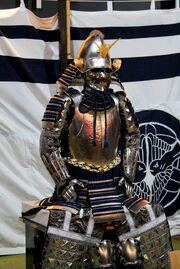
A photo of Kenshin's armor at Koei's 2009 TGS booth.
Personal Info
Uesugi Kenshin was and still is considered a man of integrity and mystery. He had several rivals on his rise to power, but he was personally not interested in ruling other lands or politics. Leaving the politics of the land to his retainers, Kenshin was more interested in sharpening his swords in preparation for the next conflict. Believing that he was the embodiment of his revered deity, Bishamonten, he was eager to fight in "beautiful combat" (some stories even state that he believed he was the reincarnation of his god). Unlike most other daimyo in his time, he was often seen in a monk's attire and is famous for wearing his white clothed hood. Even if he was dedicated to his faith, he was also known as a delicate and caring lord who would shed tears for the lives lost in his campaigns. His declarations for fighting in the name of justice and his wise strategies earned him the admiration of his vassals. Even now, there are still people in Yonezawa who argue that Kenshin was the strongest general during the Warring States era.
Kenshin is well known for his rivalry with Takeda Shingen. Both men held a similar reputation but were radically different from one another. Although it is often romanticized that both rivals respected one another greatly, it is more likely that Kenshin disliked Shingen. Shingen's flamboyant lifestyle was a sharp contrast to Kenshin's reserved mindset and it was said that Kenshin was always angered when he rode into battle against Shingen. Over time, however, his feelings towards his rival seemed to have changed. While he was dining, Kenshin heard the news of his rival's death from his vassals in 1573. He replied, "I have truly lost an excellent match before my time. There are no others in the world who can return him, be they man or child." He then dropped to the floor and wept bitterly. His vassals urged their lord to attack the crippled Takeda but Kenshin answered, "Even if I were to win with the tainted air of victory, it would be immature."
One of the most famous incidents between Kenshin and Shingen was when a number of other daimyo (including the Hōjō clan) boycotted salt supplies to Kai province. Kenshin heard of Shingen's problem with a daimyo of the Hōjō clan who refused to send rice to him. Kenshin secretly sent salt to the Takeda (salt was a precious commodity as it was used in preserving food) and wrote to his enemy that in his opinion, the Hōjō lord had committed a hostile act. Although he could have cut off Shingen's supplies and "lifeline", Kenshin decided not to do so because it would be dishonorable. In reflection, Kenshin made a statement "Wars are to be won with swords and spears, not with rice and salt." In this, Kenshin set a noble example for all time in his treatment of his rival Shingen. The statement is a common modern reference by peace advocates who in recognition of Kenshin state that "peace is to be achieved with rice and salt, not with swords and spears". As thanks, Shingen gave away a precious sword (tachi) which was forged by the revered swords smith, Fukuoka Ichimonji, to Kenshin. The sword is kept today at the Tokyo National Museum and is considered an Important Cultural Property.
His hobbies include collecting fine swords, waka poetry, singing and playing the lute. His height in modern conversions is approximately 156~157 cm (roughly between 5'1" and 5'2") and his blood type was AB. A devout monk, he had no known wives or concubines yet his celibate nature has been a subject of debate for centuries. This maybe due to his conscious recognition of love and courting in poems and stories. He had no biological children but he did adopt six children: four sons, one daughter and one that was still born from the Oda family.
Other Names
When Kenshin was born, his name was Torachiyo (虎千代). His name after his coming of age ceremony became Nagao Kagetora (長尾景虎). He changed his name to Uesugi Masatora (上杉政虎) when he inherited the Uesugi family name in order to accept the official title of Kantō Kanrei. Later he changed his name again to Uesugi Terutora (上杉輝虎) to honor the shogun Ashikaga Yoshiteru, and finally to Fushigian Kenshin (不識庵謙信) after he became a Buddhist monk.
Kenshin's nicknames on the battlefield include "Holy General" (聖将), "God of War" or "War God" (軍神), "The Tiger of Echigo" (越後の虎) or "The Dragon of Echigo" (越後の龍) due to his fearsome skills in the martial arts. His rival Shingen was called "The Tiger of Kai". In some versions of Chinese mythology, the Dragon and Tiger have always been bitter rivals who try to defeat one another, but neither is ever able to gain the upper hand. Though popular in various mediums under his dragon pseudonym, some historians speculate that he was only known as the tiger. His dragon nickname, they argue, was likely a later deviation due to one of Kenshin's war banners.
His artist name was Soushin (宗心) and his kemyou (a type of secondary alias) was Heizou (平三).
Early Years
Kenshin was born in Katsugayama Castle as the fourth (argued as third) son of Echigo's shugodai, Nagao Tamekage. His father served Uesugi Fusayoshi and Uesugi Sadazane, helping the two lords fight against their competitive relatives. After his father quelled the rebellion caused by his vassals, Jojo Sadanori and Kakizaki Kageie, he sent the seven year old Kenshin to live at Rizenji and was taught Buddhist practices by the head monk, Tenshitsu Kouiku. Tamekage apparently did this because Kenshin did not enjoy his father's company.
After the aforementioned Battle of Sanbuchi, Tamekage had either perished or retired in 1536. The Nagao family was lead by the sickly Nagao Harukage. In 1543, Kenshin experienced his coming of age ceremony and was named Nagao Kagetora. At the same time, Echigo's shugo was Uesugi Sadazane and he assisted Date Munetane's front against his adopted child, Date Sanemoto. He tried to strengthen his hold in Echigo by weakening the Date family but he failed to live up to his expectations. He began to lose the respect of the various kokujin in the area and he was seen as an inferior ruler. When Harukage's negligence resulted in a revolt from the rich families in Echigo, the thirteen year old Kenshin was enumerated for his distinguishable first battle to suppress them.
In 1545, when Kuroda Hidetada schemed to claim independence from his master, Sadazane, he knew he lacked the skill and leadership one would properly need. Therefore, he targeted the Nagao family and killed Harukage's younger brothers, Kageyasu and Kagefusa, at Katsugayama. Before he could rebel further, Kenshin ordered to suppress the rebellion in place of his older brother. Faced with Kenshin's strength, Hidetada surrendered and swore to serve Harukage until his death a year later. When more kokujin in Echigo expressed their discontent with Harukage, Kenshin and his brother's relation with one another started to become dangerous. Under pressure of other retainers and after a year of civil conflict, Harukage retired and gave leadership of the family to Kenshin in 1548. Harukage lived the rest of his days as a priest or died of illness in 1553. As the clan's leader, Kenshin relocated to Katsugayama Castle and became Echigo's shugodai when he was 19.
In 1550, Sadazane died of illness and the fate of Echigo was uncertain since he died without a successor. To fix the problem, the shogun Ashikaga Yoshiteru appointed Kenshin to become Echigo's new shugo. During the same year, Nagao Masakage opposed the decision and lead a rebellion. However, when he faced Kenshin's superior tactics and military strength, he yielded in 1551. Kenshin forgave him and employed him as his new elder statesman.
Battles of Kawanakajima
Meanwhile, the Takeda and Hojo armies lead a full-scale assault in the northern Kanto province. To counter them, Kenshin split his army into two to counter their offensive. Hojo Ujiyasu received the Uesugi offensive in Kōzuke Province at Uesugi Norimasa's position in Hirai Castle. Norimasa, who was the son of the late Uesugi Norifusa, faltered against Ujiyasu's forces and urgently asked for aid from Echigo. Kenshin lead troops at once and broke through Ujiyasu's army and peace was momentarily returned to Hirai Castle. Since the Hojo had expended their forces to reach Echigo and its boarders, they remained within the area as a threat.
In 1551, Norimasa was offered a position to succeed the family's leadership of the Yamanouchi branch but refused. He fled to seek shelter under Kenshin in 1552 and left behind his child. Since Norimasa's son was found and executed by Ujiyasu, the fate of the Uesugi family was in Kenshin's hands. In 1553, Kenshin visited the shogun.
During April through August of the same year, Shingen invaded Shinano and several kokujin in the area fled to Echigo. In May, Murakami Yoshikiyo, to aid the northern Shinano kokujin, lead 5,000 troops to counterattack and won victory over Shingen's invading army. However, he had to retreat from the Takeda's second attack. In September, Kenshin was said to have personally lead troops into northern Shinano. His soldiers break through the Takeda vanguard, take Arato Castle and attack Aoyagi Castle. The Takeda army attempted a night raid on Arato Castle and cut off the Nagao army's escape route. The soldiers tried ready to attack Kenshin from Shioda Castle, but they instead decided to hold themselves within the fort and make it the army's base. Since Shingen wanted to avoid an all-out offensive, Kenshin withdrew his troops back to Echigo. After the battle, Yoshikiyo was offered a higher rank but he declined, saying that he needed to be punished for being too fool hearty. As such, he was labeled a "rebel", but the title only strengthened his resolve to defeat the Takeda. This encounter was later known as the first battle of Kawanakajima.
In 1554, Kenshin's vassal, Kitajou Takahiro, fled to the Takeda and revolted. Kenshin voluntarily lead troops to suppress him. In 1555, the Takeda army pressured the army in Zenkouji and Kurita Hirohisa to join their side. Various lords in the north also rose their arms as the Nagao army came in. In an effort to surround Zenkouji, Kenshin headed towards the Zenkouji plains. Hirohisa and the Takeda army besieged the Kurita clan's castle, Asahiyama Castle, with an army of 3,000. To trap them and to gain a base for his forces, Kenshin built Kazurayama Castle at this time. After Shingen took Asahiyama Castle, he planned to corner Kenshin at Kawanakajima and lead troops to Saigawa. Although the Nagao army faced them in combat, neither side could reach a concise conclusion yet they continued to face each other for the remainder of the encounter. The Takeda army was believed to have eventually suffered from lack of food due to long pauses in communications with their supplies. When the Nagao army also faltered, Kenshin passed a written oath of loyalty amongst his generals. On October 15, Imagawa Yoshimoto mediated a treaty between both parties. They reconciled their differences for a time and both armies withdrew.
While his vassals and retainers were exhausted and disgruntled with their abrupt deal with the Takeda, Kenshin gradually retreated himself to praying to Bishamonten. Kenshin suddenly declared that he wanted to become a priest and headed to Mount Kōya (or Mount Hiei) in 1556. He was eventually convinced by Tenshitsu Kouiku and Nagao Masakage to abandon his new found interest and return home to his responsibilities. Upon his return, he wrote a paper oath to his vassals, swearing that he would serve them respectfully from then on and that there would be no other who would replace him as long as he lived. During his absence, the Nagao clan tried to fortify their land's defenses without engaging in active combat. Kenshin recovered in time to deal with the discontent Ōkuma Tomohide, who revolted against the Uesugi family and then fled to Kai Province.
The following year, Kenshin headed to Takemizuwake Jinja to pray for fortune in his fight with the Takeda. Around this time, Shingen had toppled the Nagao's position Katsurayama Castle and headed to Iiyama Castle. Due to heavy snowfall, the Shinetsu border was blocked but Shingen used this time to invite wavering Nagao generals to his side. In April, Kenshin finally set out and conquered several of the Takeda's northern Shinano castles. He invaded deep into the Takeda castle and tries to recapture Zenkouji; the Takeda counter by avoiding conflict. In July, Kenshin tried to attack Sanada Yukitaka's position at Amakazari Castle but failed to claim the castle. Shingen took Atari Castle away from the Nagao and restrained their movement. In August, both armies were in Uenohara and fought to an unknown conclusion. Kenshin is written to have tried to revive Asahiyama Castle, but there are no definitive results regarding his attempt. He returned to Echigo in September and his rival returned to Kai in October.
Kantou Kanrei
In 1559, Kenshin paid his respects to Emperor Ogamichi and had an audience with Ashikaga Yoshiteru. Kenshin was treated with the average respect as a kanrei. Although Kenshin and Yoshiteru shared an intimate relation with one another, Yoshiteru's statesman, Ōdara Harumitsu, tried to convince him, Shingen and Ujiyasu to reconcile their differences and attack their "common enemy", Miyoshi Nagayoshi. Kenshin was not convinced and the proposal soured his otherwise pleasant visit.
As Kenshin was traveling back to Etchu in 1560, he momentarily got involved with the rivalry between Jinbo Nagamoto and Shiina Yasutane. At first, he treated Nagamoto with attrition and favored Yasutane. However, he eventually reconciled with Nagamoto, which made Yasutane abandon the Uesugi and join the Takeda. In May, Kenshin arrives in Kanto and stays within Maebashi Castle. Gaining Matsuyama Castle through his attacks in 1561, it was given to the Kantou Kanrei, Uesugi Norimasa, and six Uesugi vassals. They use it as their base to surround Odawara Castle with 100,000 troops. However, Odawara Castle would not fall, and the soldiers were pulled back to Kamakura after a month's siege. Around this time, Kenshin requested for clan leadership of the Yamanouchi Uesugi and had it granted. With permission of the Kamakura-fu at Tsurugaoka Hachiman-gū, Kenshin inherited the Uesugi name and Norimasa's previous title, Kantou Kanrei. His name became Uesugi Masatora on March 18.
As for why exactly Kenshin was chosen remains uncertain. As the Uesugi name and court title were both family rights, it is said that Norimasa had originally desired to have adopted a child from the Satake clan, a respected family who fought with the Uesugi's common enemies. His request was apparently denied and Norimasa had no other choice but to rely on Kenshin. There is also another theory that suggests that Kenshin was actually a distant blood relative of Uesugi Yorinari, a grandson of the Uesugi founder. His son then became one in the Nagao clan. While this trace of lineage is actually a bit different than the claim suggests, the idea that Kenshin was a blood relative of the Uesugi still remains.
Fighting Shingen and Ujiyasu
Final years
Starting in the year 1576, Kenshin began to consider the issue of Nobunaga, who had since grown to be Japan's most powerful warlord of the time. With both Shingen and Hōjō Ujiyasu dead, Kenshin was no longer blocked off from this realm of expansion. So, when the death of a Noto lord in the area sparked up confusion and conflict, Kenshin was quick to use the opportunity, taking land from the weakened clan which put him in a position to threaten Nobunaga and his allies. In response, Nobunaga pulled together his own forces and those of two of his best generals: Shibata Katsuie and Maeda Toshiie to meet Kenshin at Tedorigawa.
The experienced Katsuie was sent forth to test Kenshin's famed battle reputation. According to some accounts, Katsuie led 18,000 men into battle first, and Nobunaga himself followed up with 20,000 reinforcements. If this information is accurate, it would make the battle between the two one of the largest fought in the Sengoku period. Despite Nobunaga's overwhelming numbers, Kenshin managed to score a solid victory on the field. After losing almost a quarter of his force, Nobunaga pulled back to Ōmi Province while Kenshin contented himself with building a few forts in Kaga Province before returning back to Echigo province. In the winter of 1577 and 1578, Kenshin arranged to put forth a grand army to continue his assaults into Nobunaga's land. However, he was reported to be in horrid health during this time, and on April 9 he suffered a type of seizure while using the lavatory. He died four days later.
His death poem was 「四十九年一睡の夢 一期の栄華一盃の酒」。"Forty Nine Years; One night's dream. A lifetime of prosperity; a cup of sake." (These 49 years of my life have passed like one night's dream. My life has been full of glory and prosperity, like a single cup filled with sake.)
The cause of Kenshin's death has been questioned throughout the years. The theory accepted by most Japanese scholars is that a lifetime of heavy drinking and perhaps stomach cancer spelled the end for the great warlord. Other sources hold that he was assassinated by a ninja who had been waiting in the cess pool beneath the latrine at Kenshin's camp with a short spear. It is said that upon hearing of Kenshin's death, Oda Nobunaga remarked, "Now the empire is mine."
His death was disastrous for his clan. His adopted sons quarreled over the right to be successor and eventually lead to a civil conflict in Echigo. In the end, Uesugi Kagekatsu became the clan's new ruler. However, the internal struggle had cost them greatly as Nobunaga had no problem taking over the majority of their lands quickly, going right up to their homeland.
Gallery
Gallery
|
|---|
Nobunaga's Ambition: Rise to Power portrait Sengoku comic collaboration portrait Nobunaga no Yabou ~Rin-ne~ manga appearance Uesugi Nyanshin in Samurai Cats Guruguru Dungeon Nobunyaga portrait |
Trivia
- In the Sengoku Jidai themed comic, Sengoku Angelique, Clavis acts as the Kenshin of the cast. His full name is "Uesugi Clavis Kenshin".

|
This article about a Samurai Warriors character is a stub. You can help the wiki by expanding it. |



